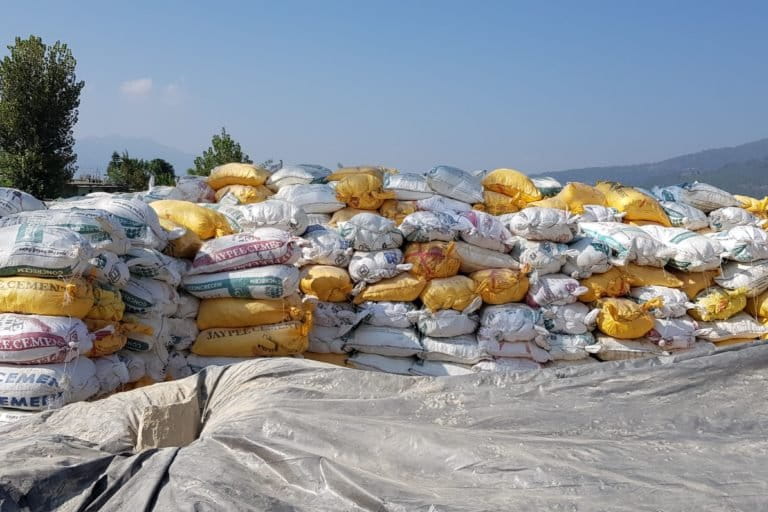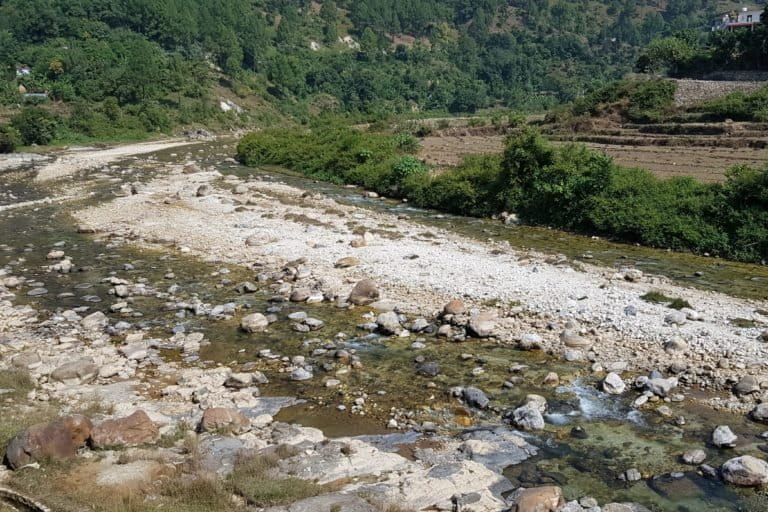- Uttarakhand’s Bageshwar district has one of the richest deposits of soapstone in India.
- However, mining in the environmentally fragile and seismically vulnerable hill region has raised many questions.
- The government claims that all norms are strictly followed and mining is well monitored but the locals and activists disagree.
On a bright sunny day in October, more than a dozen JCB machines roar together to dig and cut the hills in the picturesque Himalayan landscape of Uttarakhand. As the machines cut and punch the fragile slopes, white lumps of soapstone underneath reveal themselves and slowly, a verdant patch turns into a bright expanse of white.
This is Reema valley of Bageshwar district, situated about 600 kilometres from Delhi. It is about 1,150 metres above sea level in an ecologically fragile and highly seismic zone of the central Himalayas. These mountains hold large deposits of khadia or soapstone, which is a metamorphic rock formed by millions of years of metamorphism and metasomatism. It is one of the most valuable minerals found across the world. In India, it is sold for up to Rs. 6.000 to Rs 7,000 per ton and widely used in the paper, paint and cosmetic industry.
Bageshwar district of Uttarakhand is one of the richest spots of soapstone. Presently, the government has sanctioned 90 soapstone mines in this region and most of them are situated in Kapkot block. However, only about one-third of the sanctioned mines are functioning at this moment.
“This year, before the lockdown (due to the COVID-19 pandemic) was imposed, we had 50 mines operating in this area. At this moment, only 27 are functioning as the work has just started since October 1. Several other mine owners haven’t started the work now for various reasons but they should commence it soon,” Lekhraj, the deputy director, geology and mining department, Uttarakhand government, told Mongabay-India. Though sand mining is another major source here, soapstone remains the main revenue provider in the Bageshwar district.
In this district, a total of Rs. 193.1 million was collected from mining in 2019-20 and of that, Rs. 122.3 million came from soapstone mining. In 2018-19, Rs. 185.7 million was collected by the mining department while Rs. 111.1 million was from soapstone. In 2017-18, a total of Rs. 216.9 million was collected and of that Rs. 118.4 million came from soapstone.
This year (2020-21), despite the impact of COVID-19 a total of Rs. 65.6 million was collected by soapstone mining until September 30.
Employment and welfare from soapstone: claim and counterclaims
According to the state government officials, soapstone mining has generated employment and brought prosperity in this area.
“We had done a survey when fifty mines were working last year. Almost 2,500 workers in these mines were from outside this area. You can add 50 percent of this number as local people who have got direct or indirect employment from soapstone. A person whose land is taken for mining is benefited as he is also involved in this (mining) activity. Like some of them engage with their trucks, while some engage their JCB machine in the mining. The local people definitely get good employment,” said Lekhraj.
Lekhraj stressed that mining has lifted the ‘social status’ of people living in this area, but Jagdish Singh Bafila, the gram pradhan (village head) of Bafila village in Kapkot refutes such claims.
“They (mine owners) have not given any job to the poor or people who come from the Dalit community. Only a handful of people who help the contractors and mine owners to mislead the villagers, get all the jobs,” Bafila told Mongabay-India.
He alleged that the contractors are “cheating” the locals by using “fraudulent” ways to “capture” the land for mining.
“Even if a farmer or landowner does not want to give his fields (for mining) they forcefully damage his land. Whatever is written in the agreements between the lease owner and landowner is not followed in practice. If you see the land behind me, under the agreement, it was taken for five years but they (contractors) have it for the last seven years,” said Bafila as he showed the mined fields of the village.
Several villagers in the Reema valley had complaints similar to Bafila’s and said they were paid “inadequate” compensation.
“My land was taken in 2006-07. I got a meagre compensation of Rs. 40,000. They did not make the full payment to me and ruined my fields. I wanted to grow wheat but now I can’t cultivate my fields. They should have restored it but they aren’t listening to me,” said Mohan Singh Khati, a 35-year-old farmer.

Balwant Singh Bhauryal, the member of Uttarakhand legislative assembly declined to make any comment in response to Mongabay-India’s query. However, Rekha Arya, a senior BJP leader – who has been assigned the responsibility to look after the mining-related matters by the party, said that all the matters are supervised by the chief minister himself. She though she hasn’t visited Reema valley until now and says if people have any problem action will be taken to address their grudges.
“Nothing of such sort has come in my notice until now but generally before mining is allowed the consent is taken by the villagers and the mining is done only after that. If there is something in your knowledge please tell me. We will act. We always make an effort so that people don’t suffer due to it,” Arya told Mongabay-India.
Read more:[Video] Is mining in India ‘just’ for the environment and communities?
Welfare roadmap for development
Officials note the District Mineral Foundation Trust (DMFT) as a driver of development in the mining-affected area. This trust is set up in all 13 districts of the state and the miners have to deposit 25 percent of the royalty they pay to state exchequer additionally to the account of trust.
“The trust was formed in 2017. Between 2017 and 2020, if the mining is done, the money has also been spent on development of the affected area. The money is spent in the periphery of two kilometres of any mine. The gram pradhan and people’s representatives of the area sit with the officers of local administration and make proposals for the urgent welfare needs like the construction of school building, canal, pathways or hospitals. They bring the proposal of any work in the front of the board and we approve it as per need,” Arya who is the head of the trust, explained.
Regarding the government’s claim that the “social status” of locals has improved in recent decades because of mining, locals claim that a few have definitely gained from mining but these are close associates of contractors who got some work in a mine but otherwise the workers are labourers who come from outside.

“Over the years people have increasingly migrated to other places from this area in search of employment. They found jobs and employment in bigger towns of state or metro cities like Delhi and Mumbai and from where they return money back home. Largely people are still poor or in the low-income bracket. If anyone is socially or economically uplifted here it is not necessarily due to the mining,” Chandra Shekhar Dwivedi, a local journalist told Mongabay-India.
Read more: [Video] Rampant sand mining damaging Yamuna’s ecology
Environmentally sensitive landscape
Experts often point out that the Himalayan slopes are fragile and prone to landslides. It is also a very highly seismic zone and frequent cloudbursts make the situation even worse during monsoon. In 2019, Uttarakhand was ranked second in the country in the number of deaths due to landslides.
In 2010, at least 18 school children died in Kapkot due to a massive landslide triggered by a cloudburst. Earth scientists and geologists caution against any unregulated mining in such terrain.
“Mining anywhere generates debris and if this muck is not managed and disposed of properly then the hilly slopes become vulnerable in the case of any cloudburst. Cloudbursts regularly happen in the valleys of a specific geometry and if a place is susceptible to cloud burst, I would say it can play havoc. Therefore, the mining has to be scientific and regulated to avoid any untoward incident in such areas,” Pradeep Srivastava, a sedimentologist with the Wadia Institute of Himalayan Geology told Mongabay-India.
Locals and activists allege that mine operators have been flouting the environmental norms for decades. Radhabehen, a Gandhian associated with women’s organisation Kasturba Mahila Utthan Mandal remembers a villagers’ agitation which took place more than 15 years ago in Kapkot against a mining project.
“It was in the early 2000s when a protest broke out in the Loharkhet valley in Kapkot. That time in a village the contractor kept on digging the hill in the greed of high-quality soapstone he was getting from the deposits. Suddenly, water came out of the mine due to excessive digging. This was a water spring feeding the need on the other side of the hill where people were dependent on this water source. The mine owner tried to fill it up to cover the blunder committed by him but the people on the other side of the village got angry and protested. Finally, mining had to be stopped but the damage was already done,” Radhabehen told Mongabay-India.
Dinesh Surkhali, a 35-year-old resident of Bafila village emphasised that the “miners have the permission to dig sandstone but they hardly care about any environmental norms.”
“Dozens of JCB machines dig soapstone together in a single mine. We suffer due to noise, air and water pollution. They (mine operators) are dumping the muck in the river and it is killing the fish and riverine life. The government does not pay heed to this violation by operators.”

Government officials admit that there is some impact due to mining but they are continuously monitoring things and taking appropriate measures. Lekhraj informed Mongabay-India that a standard procedure is adopted to sanction mines and the government ensures proper compliance during operation.
“If we are working (mining) in any area, then obviously we are tampering with nature … and it is our job to restore its health. If the damage happens (by mining), we ask the mine owners for restoration work,” said Lekhraj.
He explained that the process of sanctioning mines involves several checks and balances like a mandatory environmental impact assessment study to assess the impact of the mine on the local ecology of the area and a public hearing process to consult people and address their concerns. The State Pollution Control Board is also required to give consent and regularly monitor the project to ensure that the project is not violating environmental norms.
“Even after getting permission to mine, the project operator has to take the ‘consent to operate’ certificate from the pollution control board every year. The consent is renewed only if they follow the norms,” Lekhraj said.
Locals, however, disagree. Several villagers told Mongabay-India that there is no restraint on the miners and they are fully supported by local administration even when they flout the norms. As a result, in several places, villagers often fear mishaps due to negligence.
“They (mine operators) do not make any arrangement for muck disposal. Therefore, the villagers living downhill (of mine) are always worried because this muck creates a lot of problems. I have seen villagers often complaining and protesting against such irresponsible mining because it (the muck) comes down to their houses with rain, ruins their fields and also causes landslides. So, they fear for their agriculture, property and life,” Radhabehen told Mongabay-India.
Read more: Assam’s tribal communities lost land and forest to mining
Banner image: Government claims that they have strict norms but villagers allege that soapstone mining is damaging their fields and affecting agriculture. Photo by Hridayesh Joshi.
